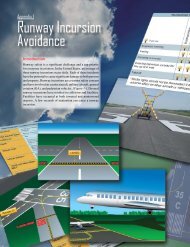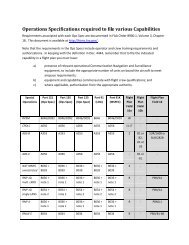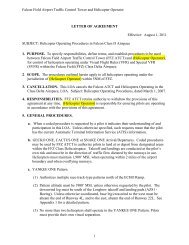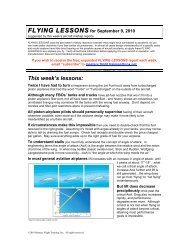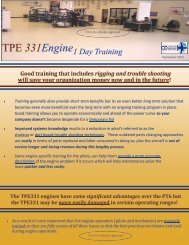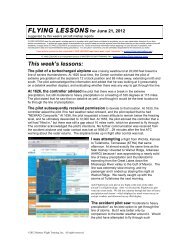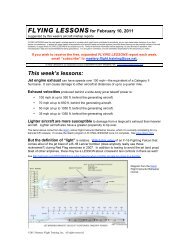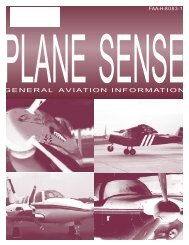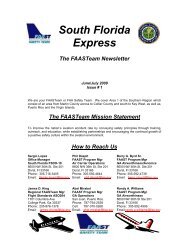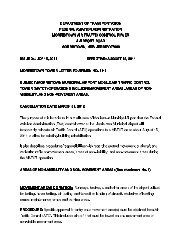110825 FLYING LESSONS.pdf - FAASafety.gov
110825 FLYING LESSONS.pdf - FAASafety.gov
110825 FLYING LESSONS.pdf - FAASafety.gov
You also want an ePaper? Increase the reach of your titles
YUMPU automatically turns print PDFs into web optimized ePapers that Google loves.
Regular Debriefer David Heberling comments on last week’s link to the NASA Callback issue on<br />
“automation fixation.” David writes:<br />
Interesting read, that Callback. Been there, done that, got the T-shirt. We are all system monitors now. It<br />
takes discipline to make yourself do effective monitoring of the automation. When in [airline] training, the<br />
mantra "FMA, FMA, FMA" is pounded into our heads. FMA is Flight Mode Annunciator. It alone tells us<br />
what mode the automation is in. It sits at the top of both of our PFDs. When making inputs into the FMC, it<br />
has to pass the "make sense" test. Did your last entry make sense Involve the other crewmember to verify<br />
the changes you are making. Yes, complacency has an appearance here, as does fatigue, schedule pressure<br />
(being rushed in preflight duties), and confusion. When I say confusion, I mean where something does not<br />
make sense, or you have a question about what the airplane is doing now. Both of these require that the pilot<br />
make his confusion known to not only his partner, but also ATC if that is warranted. When in doubt, ask for<br />
clarification.<br />
Scheduling pressure has to be managed by the captain. Aircraft swaps are notorious for putting pressure on<br />
the pilots to "hurry up". Add a maintenance item to the mix and the situation is ripe for mistakes of all<br />
kinds. When involved in an aircraft swap, make it a point to tell the First Officer to slow down and do a<br />
normal preflight. Also tell him, "Do not hurry, or mistakes will be made." If the gate agent is standing in<br />
the cockpit door tapping her foot or looking at her watch, turn around and ask them to leave. I believe that<br />
they do know they are putting pressure on us, but do not know how dangerous that is. If a maintenance item<br />
pops up, tell the gate agent that you have no idea how long it will take to address this issue but will let them<br />
know when information becomes available. You have too much to do to worry about an on time departure.<br />
In fact, maintenance issues can throw preflight preparations into disarray because it interrupts the normal<br />
flow of preparation. Many times it is prudent to start the preflight sequence all over again once the<br />
maintenance issue has been satisfactorily addressed. This is what it means to be captain. You have to show<br />
leadership by managing all the different pressures that come to bear on your flight. It is a rare F/O that steps<br />
into the void if the captain fails in his duties. However, an F/O should always let the captain know when he<br />
is not ready to go. This is not an indication of weakness, just a reminder to the captain that you will not be<br />
rushed.<br />
Many times, runway changes come late in the process you are currently in, whether you are just about to push<br />
from the gate or on the taxiway to the runway. Since the captain is taxiing the aircraft, the F/O is on his own<br />
to make the changes to the FMC. These changes have to be verified by the captain some time before taking<br />
the runway for take off. It is up to the captain to make sure this happens. Sometimes it requires pulling off<br />
into a holding pen.<br />
Bringing this home for the majority of <strong>FLYING</strong> <strong>LESSONS</strong> readers: You are the captain. There<br />
is no first officer. Not only do you have to resolve the issues and make the decisions, most of the<br />
time you do not have a qualified pilot alongside you to help, to do tasks you delegate so you have<br />
time for other actions, and act as quality control to your flying. You may have many resources to<br />
help—others aboard your airplane, ATC and others available by radio, even the checklists in your<br />
POH are in effect the airplane’s designers and manufacturers giving advice on how to fly the<br />
airplane and deal with problems. But ultimately it’s all up to you…a self-determination that brings<br />
great responsibility, one of the things that attracts many of us to flying in the first place. Thanks<br />
for your insight into the world of air carrier operations, David.<br />
Comments Questions Tell us what you think at mastery.flight.training@cox.net.<br />
Scenario 1<br />
The fourth most common way people die in general aviation airplanes is Collision<br />
with Obstacles or Terrain during Low-Altitude Maneuvering Flight. As you’ll soon<br />
see, it pains me to relate representative samples of this type of “event” (they are<br />
no “accident”) for your consideration and comments, in the hope that we can do<br />
something:<br />
The experimental Cozy Mk IV airplane flew through a 100-foot-deep rock quarry at high speed at an estimated altitude<br />
of 20 to 30 feet above ground level. One witness said he waved at the airplane as it flew directly toward him, then<br />
banked away from his bulldozer and pitched up to avoid a rock pile. The airplane then collided with the quarry wall<br />
about 20 feet from the floor of the quarry. Examination of the propeller blades revealed damage that was consistent<br />
©2011 Mastery Flight Training, Inc. All rights reserved.






